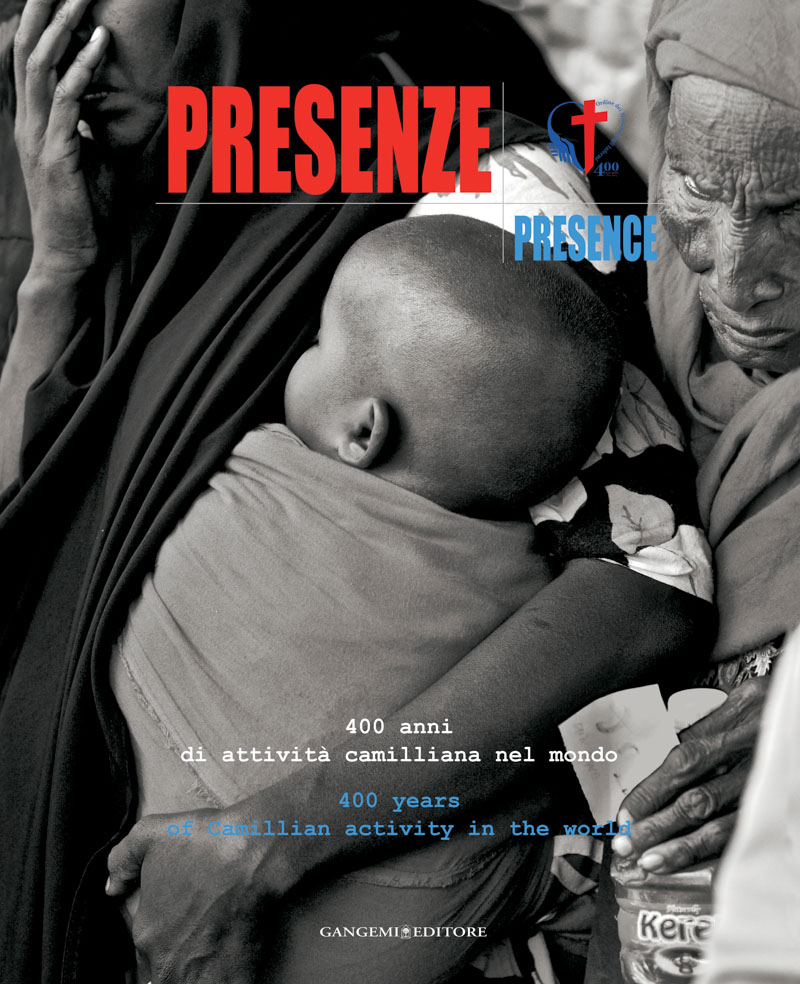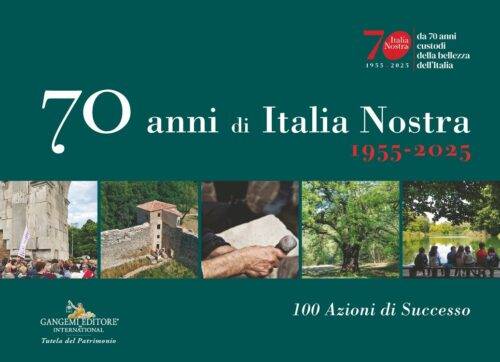
34,00 €
Potrebbero interessarti anche
Presenze – Presence
400 anni di attività camilliana nel mondo - 400 years of Camillian activity in the world
Autori: Aa.Vv.
Facing English text
Formato: 26 x 32 cm
Legatura: Filorefe
Pagine: 240
Anno edizione: 2013
ISBN: 9788849226461
EAN: 8849226462
UB. INT. : T506B V43h V24e V42e
Contenuto
Questo volume esce in occasione dell’anno giubilare in cui l’Ordine dei Ministri degli Infermi (Camilliani) celebra il 400° anniversario della morte di San Camillo de Lellis, fondatore dell’Ordine e benemerito dell’umanità, attraverso una “scuola di carità” che attualmente opera in oltre 50 Paesi nel mondo. Fedeli al carisma trasmesso dal Fondatore, i suoi seguaci hanno continuato a tenere viva la tradizione della presenza attiva, sensibile e competente al fianco del malato nel fisico, nella psiche e nell’anima testimoniando così la natura operosa e solidale di questo Ordine apparso alla fine del Cinquecento. In opposizione alla malasanità del suo tempo, Camillo propose un modello assistenziale tutto incentrato sul malato e sui suoi bisogni, cui si doveva rispondere con la stessa tenerezza di una madre verso l’unico figlio malato. Per fare questo, perciò, diventava irrinunciabile una speciale presenza capace di trasmettere calore, prossimità, partecipazione e solidarietà, umanizzando esperienze limite della vita. La calorosa e competente presenza è stata il filo conduttore dell’Ordine anche nei momenti più bui della sua storia tanto che nell’immediato post Vaticano II, alla ricerca dell’identità perduta, i Religiosi dichiararono “ci impegniamo qualitativamente con modi di presenza aggiornati, efficaci, a calarci nelle realtà locali, a vivere la nostra missione coinvolgendoci nelle sofferenze della gente”. L’esperienza di quattro secoli di servizio ci è stata tramandata dagli scritti, dai resoconti dei testimoni e dalle dichiarazioni della società civile ed ecclesiastica. A partire dalla seconda metà dell’ottocento, anche il materiale fotografico ha contribuito a fissare istantanee di vita ordinaria, del ministero attivo, della vita fraterna. Attraverso forme e canoni fotografici cangianti, l’ampio materiale fotografico raccolto negli archivi dell’Ordine ha il pregio di indicare delle influenze e delle mode e soprattutto di testimoniare la vita dei membri dell’Ordine. Nella sua ferialità e nelle grandi occasioni; nella fatica quotidiana e nella gioiosa festività; nel silenzio della preghiera e nel giocoso frastuono. Molte parole caratterizzano l’Anno Giubilare, scritte o dette: la pubblicazione sia di diversi volumi riguardanti la figura del Fondatore che della storia dell’Ordine. Questo libro vuole lasciare spazio alle immagini e limitare le parole a mero commento, a nota esplicativa, a richiamo evocativo. Al centro sta l’immagine, fissata dagli occhi di un contemporaneo, espressione di una sensibilità e di un modo di vedere che a volte sono lontani da noi. Il volume fotografico attinge a piene mani dagli Archivi propri, anche quando le fotografie ivi depositate non fossero di oggettistica camilliana ma espressione dell’affinità culturale e religiosa con altri. Alle fotografie d’epoca si integrano immagini attuali che – se possono dare l’idea di una scissione (e dal punto di vista della qualità la confermano) – hanno il pregio di contribuire ad affermare che nulla è cambiato dell’idea iniziale, da quattrocento anni a questa parte: un’idea di attiva carità, con il malato, il povero, l’emarginato al centro! Il volume non è una carrellata di luoghi e di persone, quasi una carta d’identità dell’Ordine: a questo compito già hanno provveduto altre pubblicazioni. Anzi, in sé il volume è limitativo delle espressioni geografiche e culturali di un Ordine che spazia sui cinque continenti e offre una vasta gamma di servizi socio sanitari. L’autore aspira piuttosto a cogliere quei tratti essenziali dello spirito dell’Ordine, del suo modo di essere, così come emergono dalle immagini fotografiche: molte di esse, infatti, sarebbero già sufficienti a farci capire lo spirito di un’epoca, le tensioni ad essa inerenti, la forma spirituale vissuta, le priorità dichiarate o inconsce. Per questa ragione il volume, piuttosto che descrittivo, è suggestivo permettendo di cogliere nell’immagine lo spirito di un gesto. Ovviamente, ogni corpo vivente – biologico o sociale che sia – ha un assetto interno, un’organizzazione che ne permette il corretto funzionamento e lo sviluppo. L’Ordine dei Camilliani ruota attorno alla fraternità costruita sulla vita spirituale e realizzata nella missione: questi tre ambiti, intersecanti, sono qui testimoniati come abbozzi su una tela piuttosto che come dati statistici. Bastano le immagini a renderci l’idea che sempre la vita dei religiosi Camilliani si è sostenuta nella pratica dell’orazione, nella calda fraternità e nella generosa missione, specie in situazioni di estrema difficoltà, a soddisfare il voto “della donazione personale anche a rischio della vita”. Una storia per immagini è anche un’immagine di una storia: non si può cogliere tutto, perché quello che è vero rimane pur sempre intimo; e ogni immagine coglie la realtà da una particolare prospettiva focalizzandosi su alcuni aspetti e trascurandone altri. Tuttavia le immagini non sono una finzione, ma un’utile finestra sulla vita dell’Ordine: da essa si ha l’opportunità di spingere il proprio sguardo sulle epoche passate per capire il presente e meglio costruire il futuro.
Dalla prefazione di P. Renato Salvatore – Superiore generale
This volume has been published on the occasion of the jubilee year when the Order of the Ministers of the Sick (Camillians) are celebrating the fourth centenary of the death of St. Camillus de Lellis, the founder of the Order that was to be a ‘new school of charity’ which at the present time works in over fifty countries throughout the world. Faithful to the charism handed down by the Founder, his followers have contributed to keeping alive the tradition of active, sensitive and competent presence at the side of the sick ‘in body, mind and spirit’. In this way they bear witness to the hard-working and solidarity-inspired nature of this Order, which came into being at the end of the sixteenth century. Contrary to the philosophy in vogue at the time, Camillus proposed a model of care that was completely centred on the sick person and his or her needs. This meant responding with the same tenderness as a mother would have for her only child who was sick. This required the ability to transmit human warmth, solidarity and compassion. Compassion coupled with competence has been the leading theme of the Order ‘even during the darkest moments of its history’. And so in the aftermath of the Second Vatican Council, when like most other congregations we were searching for our roots, the religious declared: ‘we pledge ourselves to live our mission by involving ourselves in the world of suffering using updated and effective forms of presence in local realities”. The experience of four centuries of service has been handed down to us in the written accounts of witnesses, and by the declarations of civil society and ecclesiastical society. From the middle of the nineteenth century onwards, photographic material also contributed to the recording of moments of our ordinary life, our active ministry and our fraternal life. Through changing photographic forms and canons, the material collected in the archives of the Order indicates varying influences and fashions and, above all, testifies to the lives of members of the Order, both at work, prayer and at play. There will be many different publications during this jubilee year. This book wants to provide space for images, limiting words to explanatory notes and evocative references. At the centre is the image, established by the eyes of a contemporary, and the expression of a sensitivity and of a way of seeing things that at times are distant from us. This volume of photographs draws to the full on our archives, even when the photographs deposited there are not of a Camillian character but the expression of cultural and religious affinity with other people. The photographs of a particular period are supplemented by contemporary photographs which, although they give the idea of a scission (and this is confirmed by their quality), have the positive feature of helping to establish that nothing has changed as regards the initial idea of four hundred years ago: an idea of active charity with the sick, the poor, and the marginalised at the centre of things! This volume is not a compliationof places and people, almost an identity card of the Order: other publications have already performed this task. Indeed, in itself this volume is limited as regards the geographical and cultural expressions of an Order that ranges across the five continents of the world and offers a vast gamut of social/health-care services. The author aspires, rather, to grasp those essential features of the spirit of the Order, of its way of being, as these emerge from the photographic images: many of them, in fact, would already be sufficient to enable us to understand the spirit of a particular period, the tensions inherent in it, the spiritual form that was experienced, and the declared or unconscious priorities. For this reason, this volume, rather than being descriptive is suggestive, allowing the reader to understand through a picture the spirit of a deed. Obviously, every living thing – whether biological or social – has an internal system, an organisation that allows its correct working and development. The Order of St. Camillus revolves around fraternity, built on the spiritual life and achieved in its mission: these three areas, which intersect, are here testified to as drafts on a canvas rather than statistical data. Pictures are enough to make clear the idea that the lives of Camillian religious have always been sustained in practice by prayer, in warm fraternity and in generous mission, especially in situations of extreme difficulty, in order to live up to the vow of ‘personal self-giving even at risk to life’. A history in pictures is also an image of history: one cannot understand everything because what is true always remains intimate; and every image expresses the reality of a particular perspective by focusing in on certain aspects and neglecting others. However, the pictures are not fiction: they area useful window onto the life of the Order – from that window one has an opportunity to extend one’s gaze to past epochs in order to understand the present and construct the future in a better way.
From the preface of Fr. Renato Salvatore – Superior General
Parole chiave
Condividi su













